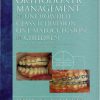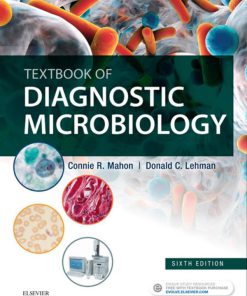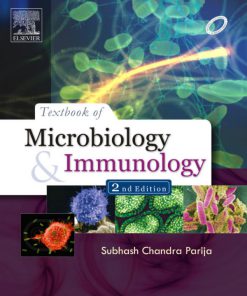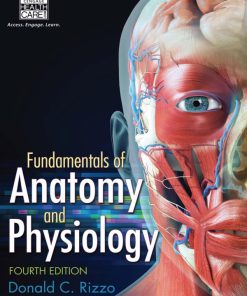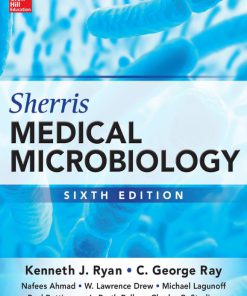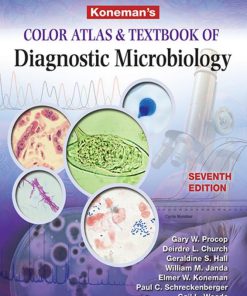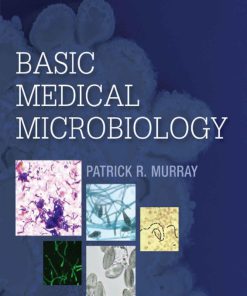Textbook of Diagnostic Microbiology 6th Edition by Connie R Mahon, Donald C Lehman, George Manuselis ISBN 0323482120 9780323482127
$50.00 Original price was: $50.00.$25.00Current price is: $25.00.
Authors:Connie R. Mahon; Donald C. Lehman; George Manuselis , Series:Pathology [213] , Author sort:Mahon, Connie R. & Lehman, Donald C. & Manuselis, George , Ids:9780323482127 , Languages:Languages:eng , Published:Published:Jan 2018 , Publisher:Elsevier Health Sciences
Textbook of Diagnostic Microbiology 6th Edition by Connie R Mahon, Donald C Lehman, George Manuselis – Ebook PDF Instant Download/Delivery. 0323482120, 9780323482127
Full download Textbook of Diagnostic Microbiology 6th Edition after payment
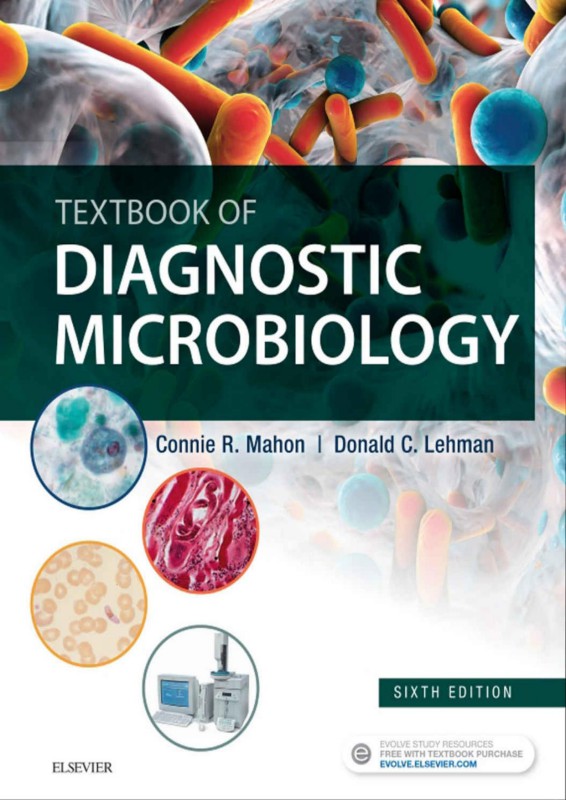
Product details:
ISBN 10: 0323482120
ISBN 13: 9780323482127
Author: Connie R Mahon, Donald C Lehman, George Manuselis
Learn to develop the problem-solving skills necessary for success in the clinical setting! The Textbook of Diagnostic Microbiology, 6th Edition uses a reader-friendly “building-block” approach to the essentials of diagnostic microbiology. This updated edition has new content on viruses like Zika, an expanded molecular chapter, and the latest information on prevention, treatment modalities, and CDC guidelines. Updated photos offer clear examples of automated lab instruments, while case studies, review questions, and learning objectives present information in an easy-to-understand, accessible manner for students at every level.
- A building-block approach encourages you to use previously learned information to sharpen critical-thinking and problem-solving skills.
- Full-color design, with many full-color photomicrographs, prepares you for the reality of diagnostic microbiology.
- A case study at the beginning of each chapter provides you with the opportunity to form your own questions and answers through discussion points.
- Hands-on procedures describe exactly what takes place in the micro lab, making content more practical and relevant.
- Agents of bioterrorism chapter furnishes you with the most current information about this hot topic.
- Issues to Consider boxes encourages you to analyze important points.
- Case Checks throughout each chapter tie content to case studies for improved understanding.
- Bolded key terms at the beginning of each chapter equip you with a list of the most important and relevant terms in each chapter.
- Learning objectives at the beginning of each chapter supply you with a measurable outcome to achieve by completing the material.
- Review questions for each learning objective help you think critically about the information in each chapter, enhancing your comprehension and retention of material.
- Learning assessment questions at the conclusion of each chapter allow you to evaluate how well you have mastered the material.
- Points to Remember sections at the end of each chapter identify key concepts in a quick-reference, bulleted format.
- An editable and printable lab manual provides you with additional opportunities to learn course content using real-life scenarios with questions to reinforce concepts.
- Glossary of key terms at the end of the book supplies you with a quick reference for looking up definitions.
- NEW! Content about Zika and other viruses supplies students with the latest information on prevention, treatment modalities, and CDC guidelines.
- NEW! Expanded Molecular Diagnostics chapter analyzes and explains new and evolving techniques.
- NEW! Updated photos helps familiarize you with the equipment you’ll use in the lab.
- NEW! Reorganized and refocused Mycology chapter helps you better understand the toxicity of fungi.
- NEW! Updated content throughout addresses the latest information in diagnostic microbiology
Textbook of Diagnostic Microbiology 6th Table of contents:
Part I Introduction to Clinical Microbiology
Chapter 1 Bacterial Cell Structure, Physiology, Metabolism, and Genetics
Significance
Overview of the Microbial World
Classification/Taxonomy
Comparison of Prokaryotic and Eukaryotic Cell Structure
Bacterial Morphology
Microbial Growth and Nutrition
Bacterial Biochemistry and Metabolism
Bacterial Genetics
Bibliography
Chapter 2 Host-Parasite Interaction
Origin of Microbial Biota
Composition of Microbial Biota at Different Body Sites
Role of the Microbial Biota in the Pathogenesis of Infectious Disease
Role of the Microbial Biota in the Host Defense Against Infectious Disease
Microbial Factors Contributing to Pathogenesis and Virulence
Host Resistance Factors
Mechanisms by Which Microbes May Overcome Host Defenses
Bibliography
Chapter 3 The Laboratory Role in Infection Control
General Concepts in Infection Prevention and Control Practice
Outbreak Investigation
Education
Emerging and Reemerging Pathogens
Bibliography
Chapter 4 Control of Microorganisms
Disinfection and Sterilization
Sterilization Versus Disinfection
Factors That Influence the Degree of Killing
Methods of Disinfection and Sterilization
Disinfectants Versus Antiseptics
Environmental Protection Agency Regulations on Chemical Surface Disinfectants
Food and Drug Administration Regulations on Chemical Skin Antiseptics
Microbiology Safety
General Laboratory Safety
Bioterrorism and the Clinical Microbiology Laboratory
Bibliography
Chapter 5 Performance Improvement in the Microbiology Laboratory
General Guidelines for Establishing Quality Control
Performance Improvement
Evaluating and Interpreting Diagnostic Laboratory Tests
Analytic Analysis of Tests
Clinical Analysis of Tests
Operational Analysis of Tests
Choosing a Laboratory Method
Test Validation
Bibliography
Chapter 6 Specimen Collection and Processing
Basic Principles of Specimen Collection
Preservation, Storage, and Transport of Specimens
Specimen Receipt and Processing
Culture Workup
Communication of Laboratory Findings
Bibliography
Chapter 7 Microscopic Examination of Materials From Infected Sites
Preparation of Samples
Stains
Microscopes
Terminology for Direct Examinations
Examination of Prepared Material
Grading or Classifying Materials
Reports of Direct Examinations
Initiation of Special Handling for Unsuspected or Special Pathogens
Quality Control in Direct Microscopic Interpretations
Examples of Sample Observations and Reports
Bibliography
Direct Examination Showing Local and Contaminating Materials
Direct Examination in Common Bacterial Infections
Direct Examination in Gram-Positive Bacillary Infections
Direct Examination in Uncommon Gram-Positive Bacilli
Direct Examination in Gram-Positive Bacilli with Filaments and Branches
Direct Examination in Selected Gram-Negative Bacterial Infections
Direct Examination in Selected Gram-Negative Bacillary Infections
Direct Examination in Polymicrobial Infections
Direct Examination in Fungal Infections
Direct Examination in Parasitic Infections
Direct Examination in Viral Infections
Chapter 8 Use of Colony Morphology for the Presumptive Identification of Microorganisms
Importance of Colony Morphology as a Diagnostic Tool
Initial Observation and Interpretation of Cultures
Gross Colony Characteristics Used to Differentiate and Identify Presumptively Microorganisms
Colonies with Multiple Characteristics
Growth of Microorganisms in Liquid Media
Bibliography
Chapter 9 Biochemical Identification of Gram-Negative Bacteria
Carbohydrate Utilization
Glucose Metabolism and Its Metabolic Products
Amino Acid Utilization
Miscellaneous Tests
Manual Multitest Systems
Rapid and Automated Identification Systems
Bibliography
Chapter 10 Immunodiagnosis of Infectious Diseases
Antibodies in Serologic Testing
Antigen Detection
Principles of Immunologic Assays
Use of Serologic Testing in Specific Diseases
Direct Antigen Detection Assays
Bibliography
Chapter 11 Applications of Molecular Diagnostics
Nucleic Acid Hybridization Techniques
Nucleic Acid Amplification Procedures
Strain Typing and Identification
Future of Molecular Diagnostics Testing in the Clinical Microbiology Laboratory
Nanomedicine
Bibliography
Chapter 12 Antibacterial Mechanisms of Action and Bacterial Resistance Mechanisms
Antimicrobial Targets and Mechanisms of Action
Mechanisms of Antimicrobial Resistance
β-Lactamase Inhibitors
Dissemination of Resistance Determinants
Nanotechnology to Deliver Therapeutic Agents
Bibliography
Chapter 13 Antimicrobial Susceptibility Testing
Procedures in Antimicrobial Susceptibility Testing
Reasons and Indications for Performing Antimicrobial Susceptibility Tests
Selecting Antimicrobial Agents for Testing and Reporting
Traditional Antimicrobial Susceptibility Test Methods
Automated Antimicrobial Susceptibility Test Methods
Interpretation of In Vitro Antimicrobial Susceptibility Test Results
Methods of Detecting Antimicrobial-Inactivating Enzymes
Quality Control of Antimicrobial Susceptibility Tests
Selecting an Antimicrobial Susceptibility Test Method
Susceptibility Testing Challenges
Special Antimicrobial Susceptibility Tests
Minimum Bactericidal Concentration Test
Time-Kill Assays
Synergy Tests
Serum Bactericidal Test
Molecular Probes for Identifying Determinants of Antimicrobial Resistance
Measurement of Antimicrobial Agents in Serum and Body Fluids
Bibliography
Part II Laboratory Identification of Significant Isolates
Chapter 14 Staphylococci
General Characteristics
Clinically Significant Species
Laboratory Diagnosis
Antimicrobial Susceptibility
Bibliography
Chapter 15 Streptococcus, Enterococcus, and Other Catalase-Negative, Gram-Positive Cocci
General Characteristics
Clinically Significant Streptococci and Streptococcus-Like Organisms
Laboratory Diagnosis
Bibliography
Chapter 16 Aerobic Gram-Positive Bacilli
Non–Spore-Forming, Nonbranching, Catalase-Positive Bacilli
Non–Spore-Forming, Nonbranching, Catalase-Negative Bacilli
Non–Spore-Forming, Branching, Aerobic Actinomycetes
Spore-Forming, Nonbranching, Catalase-Positive Bacilli
Bibliography
Chapter 17 Neisseria Species and Moraxella catarrhalis
General Characteristics
Pathogenic Neisseria Species
Commensal Neisseria Species
Bibliography
Chapter 18 Haemophilus, HACEK, Legionella, and Other Fastidious Gram-Negative Bacilli
Chapter Outline
Objectives
Key Terms
Haemophilus
HACEK Group
Capnocytophaga
Pasteurella
Brucella
Francisella
Bibliography
Chapter Outline
Objectives
Key Terms
Legionella
Laboratory Diagnosis
Bordetella
Bibliography
Chapter 19 Enterobacteriaceae
General Characteristics
Opportunistic Members of the Family Enterobacteriaceae and Associated Infections
Primary Intestinal Pathogens of the Family Enterobacteriaceae
Other Genera of the Family Enterobacteriaceae
Laboratory Diagnosis of Enterobacteriaceae
Bibliography
Chapter 20 Vibrio, Aeromonas, and Campylobacter Species
Vibrio
Aeromonas
Campylobacter and Campylobacter-Like Species
Bibliography
Chapter 21 Nonfermenting and Miscellaneous Gram-Negative Bacilli
General Characteristics of Nonfermenters
Clinically Significant Nonfermentative, Gram-Negative Bacilli
Less Commonly Encountered Nonfermentative, Gram-Negative Bacilli
Bibliography
Chapter 22 Anaerobes of Clinical Importance
Important Concepts in Anaerobic Bacteriology
Frequently Encountered Anaerobes and Their Associated Diseases
Specimen Selection, Collection, Transport, and Processing
Procedures for Identifying Anaerobic Isolates
Antimicrobial Susceptibility Testing
Treatment of Anaerobe-Associated Diseases
Bibliography
Chapter 23 The Spirochetes
Leptospires
Borreliae
Treponemes
Bibliography
Chapter 24 Chlamydia, Rickettsia, and Similar Organisms
Chlamydiaceae
Rickettsiaceae and Similar Organisms
Bibliography
Chapter 25 Mycoplasma and Ureaplasma
General Characteristics
Clinical Infections
Laboratory Diagnosis
Antimicrobial Susceptibility
Interpretation of Laboratory Results
Bibliography
Chapter 26 Mycobacterium tuberculosis and Nontuberculous Mycobacteria
General Characteristics
Clinical Significance of the Mycobacterium Tuberculosis Complex
Clinical Significance of Nontuberculous Mycobacteria
Mycobacterium leprae
Isolation and Identification of Mycobacteria
Susceptibility Testing of Mycobacterium tuberculosis
Immunodiagnosis of Mycobacterium tuberculosis Infection
Bibliography
Chapter 27 Medically Significant Fungi
General Characteristics
Taxonomy
Mycoses
Clinically Significant Species
Laboratory Diagnosis of Fungi
Immunodiagnosis of Fungal Disease
Antifungal Susceptibility
Bibliography
Chapter 28 Diagnostic Parasitology
General Concepts in Parasitology Laboratory Methods
Medically Important Parasitic Agents
Bibliography
Chapter 29 Clinical Virology
Characteristics of Viruses
Laboratory Diagnosis of Viral Infections
Double-Stranded DNA Viruses
Single-Stranded DNA Viruses
Double-Stranded RNA Viruses
Single-Stranded RNA Viruses
Hepatitis Viruses
Prions
Antiviral Therapy
Bibliography
Chapter 30 Agents of Bioterror and Forensic Microbiology
Laboratory Response Network
General Characteristics of Biological Threat Agents
Biosafety
Biosafety Levels
Agents of Bioterror
Other Biological Agents and Toxins
Pandemic Preparedness and Bioterrorism Readiness
Concluding Thoughts
Forensic Microbiology
Bibliography
Chapter 31 Biofilms
Microbial Biofilms Defined
Architecture of Biofilms
Biofilm Properties
Mechanisms of Pathogenicity
Diseases Associated with Biofilms
Laboratory Consequences Associated with Biofilms
Detection of Biofilms
Potential Interventions
Bibliography
Part III Laboratory Diagnosis of Infectious Diseases: An Organ System Approach to Diagnostic Microbiology
Chapter 32 Upper and Lower Respiratory Tract Infections
General Concepts of Infectious Diseases of The Respiratory Tract
Host Risk Factors
Virulence Factors of Pathogenic Organisms
Upper Respiratory Tract Infections
Lower Respiratory Tract Infections
Respiratory Tract Infections in the Immunocompromised Host
Bioterrorism and Respiratory Infections
References
Chapter 33 Skin and Soft Tissue Infections
Anatomy of the Skin
Localized Bacterial and Fungal Skin Infections
Dermatologic Manifestations of Systemic Bacterial and Fungal Infections
Viral Infections
Parasitic Infections
Immune- or Toxin-Mediated Dermatologic Manifestations of Infectious Agents
Laboratory Diagnosis
Bibliography
Chapter 34 Gastrointestinal Infections and Food Poisoning
Evaluating Gastrointestinal Infections and Food Poisoning
Anatomic Considerations
Approach to Diagnosis of the Patient with Diarrhea
Clinical Presentation and Pathogenic Mechanisms of Acute Diarrhea
Common Viral, Bacterial, and Parasitic Pathogens
Diarrhea in Special Circumstances
Laboratory Diagnosis of Gastrointestinal Pathogens
Treatment and Prevention of Diarrhea
Bibliography
Chapter 35 Infections of the Central Nervous System
General Concepts Related to Infections of the Central Nervous System
Central Nervous System Infections
Laboratory Diagnosis
Bibliography
Chapter 36 Bacteremia and Sepsis
General Concepts Related to Bacteremic Infections
Epidemiology
Causes
Pathogenesis
Clinical Aspects of Bacteremia
Laboratory Diagnosis
Treatment
Prevention
Bibliography
Chapter 37 Urinary Tract Infections
Introduction
The Urinary System
Epidemiology and Risk Factors
Clinical Signs and Symptoms
Causes of Urinary Tract Infections
Laboratory Diagnosis
Microbial Detection
Interpretation of Results
Susceptibility Reporting
Bibliography
Chapter 38 Genital Infections and Sexually Transmitted Infections
Urethritis
Cervicitis
Vulvovaginitis
Genital Ulcer Disease
Acquired Immunodeficiency Syndrome
Other Sexually Transmitted Diseases
Bibliography
Chapter 39 Infections in Special Populations
Health Care–Associated Infections
Ventilator-Associated Pneumonia
Malignancy
Acquired Immunodeficiency Syndrome
Complement Deficiency
Burns
Organ Transplantation
Postsplenectomy Sepsis
Cystic Fibrosis
Diabetes
Aging
Pregnancy, the Fetus, and the Neonate
Bibliography
Chapter 40 Zoonotic Diseases
Key Terms
Transmission by Scratches and Bites From Domestic or Wild Animals
Transmission by Direct Contact or Inhalation
Transmission by Arthropod Vectors
Emerging Zoonoses
Bibliography
Chapter 41 Ocular Infections
General Concepts Related to Ocular Infections
Infections of the Conjunctivae
Infections of the Eyelids
Infections of the Cornea
Infections of the Sclera and Episclera
Infections of the Orbit
Infections of the Lacrimal Apparatus
Infections of the Intraocular Chambers
Biofilm-Centered Ocular Infections
Laboratory Diagnosis of Ocular Infections
Bibliography
Appendix A Selected Bacteriologic Culture Media
Acetate Agar
Alkaline Peptone Water
American Trudeau Society Medium
Bacteroides Bile Esculin Agar
Bile Esculin Agar
Bismuth Sulfite Agar
Blood Agar, Anaerobic, Brucella Base, Wadsworth
Blood Agar, Anaerobic, CDC
Blood Agar, Anaerobic, Laked, With Kanamycin, Vancomycin, and Vitamin K
Blood Agar, Anaerobic, With Kanamycin and Vancomycin
Blood Agar, Rabbit
Blood Agar, Sheep
Blood Phenylethyl Alcohol Agar, Anaerobic, CDC
Bordet-Gengou Blood Agar
Brain-Heart Infusion Broth
Buffered Charcoal Yeast Extract Agar
Burkholderia cepacia Agar
Burkholderia cepacia Selective Agar
Campylobacter Blood Agar (Campy-BA)
Campylobacter Charcoal Differential Agar
Campylobacter Thioglycolate Broth
Cefsulodin-Irgasan-Novobiocin
Cetrimide Agar
Chocolate Agar
CHROMagars
Citrate Agar, Simmons
Columbia Agar With and Without 5% Sheep Blood
Cooked Meat (Chopped Meat Glucose) Medium
Cycloserine Cefoxitin Fructose Agar
Cystine Tryptic Agar With Sugar
Decarboxylase Test Medium (Moeller)
Deoxyribonuclease (DNase) Test Agar
Dilute Gelatin Medium (0.4%)
Egg Yolk Agar, CDC Formulation
Eosin–Methylene Blue Agar
Esculin Agar
Fletcher Semisolid Medium for Leptospira
Gelatin Medium (Nutrient)
Gram-Negative Broth
Haemophilus Test Medium
Hektoen Enteric Agar
Hippurate Broth
Hydrogen Sulfide, Lead Acetate
Kligler Iron Agar
Lim Broth
Loeffler Coagulated Serum Slant
Löwenstein-Jensen Medium
Lysine Iron Agar
MacConkey Agar
MacConkey Sorbitol Agar
Malonate Broth
Mannitol Salt Agar
Methyl Red Voges-Proskauer Medium
Middlebrook 7H10 and 7H11 Agars
Mitchison 7H11 Selective Agar
Modified Thayer-Martin Agar
Motility Test Medium
Mueller-Hinton Agar
Mueller-Hinton Agar With 2% NaCl
Mueller-Hinton Agar With 4% NaCl and 6 µg Oxacillin
New York City Medium
Nitrate Reduction Broth
Nutrient Agar
Oxidative-Fermentative Medium (Hugh and Leifson Formulation)
Oxidative-Fermentative Polymyxin B–Bacitracin-Lactose Agar
Peptone–Yeast Extract–Glucose Broth
Phenylalanine Deaminase Agar
Phenylethyl Alcohol Agar
Potassium Tellurite Blood Agar
PPLO Agar
Regan-Lowe Medium
Salmonella-Shigella Agar
Schaedler Agar
Selenite Broth
Sodium Chloride Broth, 6.5%
SP-4 Broth and SP-4 Agar
Streptococcus-Selective Agar
Tetrathionate Broth
Thioglycollate Broth, Basal and Enriched
Thiosulfate Citrate Bile Salts Sucrose Agar
Tinsdale Agar
Todd-Hewitt Broth With Gentamicin and Nalidixic Acid
Triple Sugar Iron Agar
Trypticase Soy Agar
Trypticase Soy Broth
Tryptophan Broth, 1%
Urea Agar and Broth
Vaginalis Agar
Xylose-Lysine-Desoxycholate Agar
Bibliography
Appendix B Selected Mycology Media, Fluids, and Stains
People also search for Textbook of Diagnostic Microbiology 6th:
textbook of diagnostic microbiology
koneman’s color atlas and textbook of diagnostic microbiology
koneman’s textbook of diagnostic microbiology
mahon textbook of diagnostic microbiology pdf
color atlas and textbook of diagnostic microbiology pdf
You may also like…
eBook PDF
Fundamentals of Anatomy and Physiology 4th edition by Donald C Rizzo 9781305464773 130546477X
eBook PDF
Inderbir Singh Textbook of Anatomy 6th edition by SESHAYYAN SUDHA ISBN 9352501151 9789352501151



